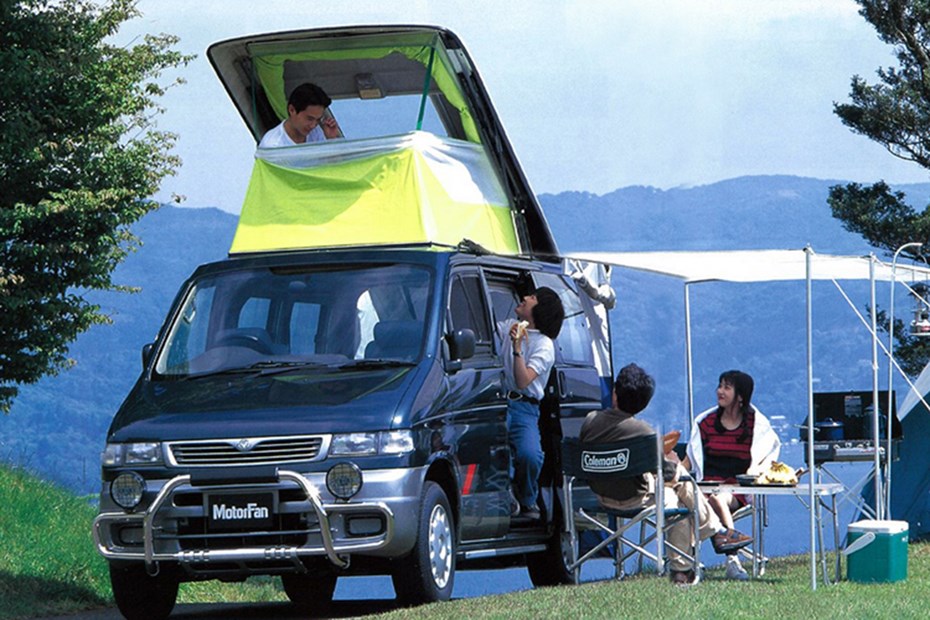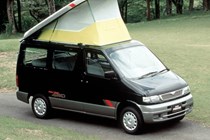The Mazda Bongo Friendee may be a regular on lists of weird car names, but it’s one of the UK’s most popular campervans. Yet it was never officially sold here. See, it’s one of those Japanese domestic market (JDM) vehicles that gained a huge following in the UK when enterprising traders started importing them by the boatload.
The Friendee was particularly popular because it was available from the factory with a lift-up ‘pop top’. The back seats could be folded down to form a bed, as well, though it was never actually sold as a fully fitted-out campervan. But that pop-top on a box-shaped MPV body meant it was an easy job to convert a Friendee into a campervan and a cottage industry sprang up in the UK to do exactly that.
The Mazda Bongo Friendee remains a great option if you’re looking for a campervan, especially one that won’t break the bank. You can get one that’s already been converted for less than £15,000, and you can get one that needs converting for less than £5,000. But there’s much that you need to know before taking the plunge and you’ll find it all in this guide.
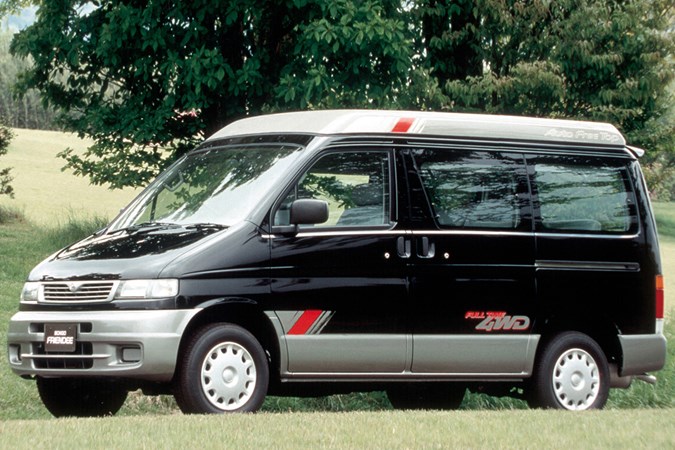
What is the Mazda Bongo Friendee?
The Mazda Bongo Friendee is a JDM eight-seater MPV that was on sale from 1995 to 2005. It was also sold as the Ford Freda – Ford owned 25% of Mazda at the time. It’s based on the same platform as the Mazda Bongo van, a humdrum commercial vehicle with the engine and front axle under the front seats. In the Friendee, the front axle was moved ahead of the interior for a more car-like driving experience, though the engine remained where it was.
Now, none of this is particularly unusual. Big, boxy eight-seat MPVs with similar commercial vehicle origins were extremely popular in Japan in the mid-1990s. But what made the Friendee stand out from the rest was the hugely popular factory-fitted pop top option. Known as Auto Free Top, it lifts up to create a vast amount of extra headroom in the interior, or it can be screened off and used as a double bedroom. Buyers could also spec air conditioning, electric blinds and side door and a rudimentary pull-out kitchen for the boot. It wasn’t a full campervan, but you could spend a week or more in one in relative comfort.
Under the front seat, there’s a choice of 2.0-litre four-cylinder or 2.5-litre V6 petrol engines, or a 2.5-litre four-cylinder turbo diesel. The 2.0 petrol and 2.5 TD have a manual gearbox as standard, or an optional automatic. The V6 is auto-only. There are rear-wheel-drive and four-wheel-drive models, as well.
A facelift was applied in 2001. The most obvious changes were a new front grille and headlights, though the whole vehicle got a slightly smoother look. Mazda didn’t bother to replace the Friendee since the Toyota Alphard and Nissan Elgrand were hoovering up all the big MPV buyers.
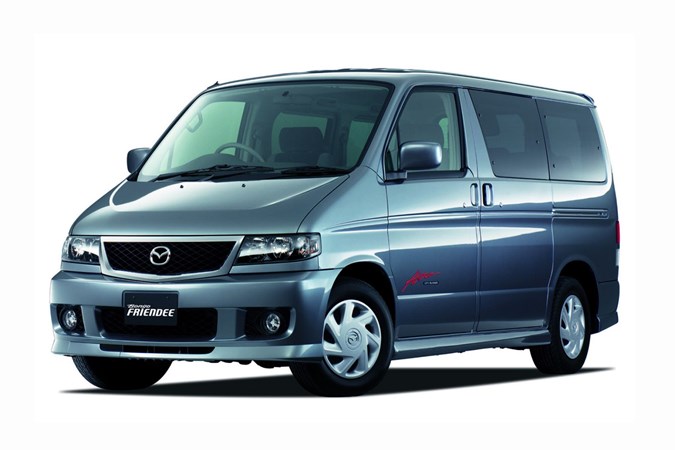
How did the Mazda Bongo Friendee get to the UK?
Japanese regulations make it difficult to own a vehicle that’s more than seven years old. It’s a ploy to prop up Japan’s vast car industry, So, when most cars on Japan’s roads reach seven years old, they’re simply thrown away. Or they were, until an enterprising band of British car traders discovered them in the 1990s.
JDM cars tend to be kept in very good condition, they’re usually generously equipped, they need little work to make them legal in the UK and, crucially, they’re right-hand-drive. Add that lot to a very favourable exchange rate in the 1990s and it was a no-brainer to import used cars from Japan to the UK. In massive numbers. 30 years later, the trade still thrives.
JDM MPVs have always been particularly popular. They’re generally more spacious and lavishly appointed than European equivalents and have sliding rear side doors. It took no time at all to realise they could be easily converted into campervans – many already had been in Japan – which added to their popularity.
The Mazda Bongo Friendee started appearing on UK roads around 2000. The factory-fitted pop-top made it a doddle to convert into a campervan and soon they were everywhere. Though the youngest of them are now 20 years old, a steady supply of fresh imports is still arriving in the UK. Diesel automatics have traditionally been most popular in the UK, but it’s now mostly petrol automatics coming over.
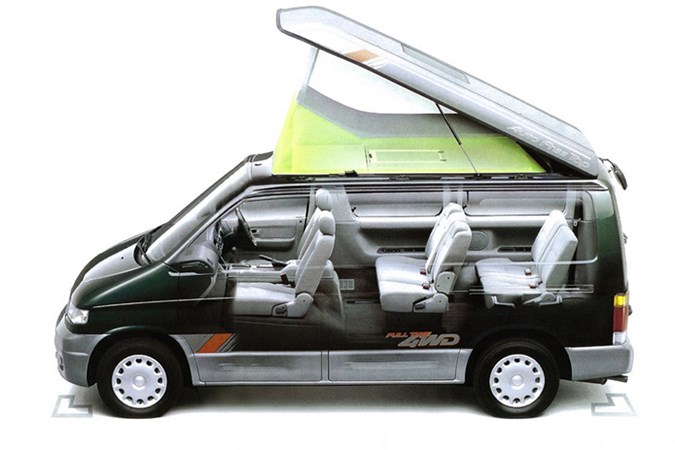
Is the Mazda Bongo Friendee any good?
Yes, for an MPV with roots in a van from the late 1980s. Sounds like damning with faint praise and, to an extent, it is. The age of the vehicle’s design is obvious in many ways. The dashboard looks and feels very plasticky. It feels much more like a van to drive than car-based European MPVs. It’s not fast in any way (even with the V6 engine) and gets through a lot of fuel (especially with the V6 engine).
And yet. All eight seats are hugely comfortable and provide a vast amount of space. The front seats might a bit high up for some people, but you can just walk into the back via the sliding door. It’s very easy to drive and the ride is nice and smooth. Most models have air conditioning as standard, which you really want in this type of vehicle.
The interior is hugely flexible, as well. The front seats can be converted to face the back by sliding the backrest forward and flipping down a little plinth to sit on. Both rows of back seats are three-seater benches that slide backwards and forwards to create more legroom, fold forward for more cargo space, or fold flat to create a – rather lumpy – bed. The back seats can be removed, but it’s a multi-person job. Row two’s backrest folds down in a 60/40 split to make getting into row three easier. The sliding door is on the left-hand-side.
Even if you’re just going to use it as an MPV, there’s a lot to recommend the Friendee. It’s not as sophisticated as a contemporary Renault Espace, or as lavish as a Nissan Elgrand, but it’s a solid, likeable workhorse.
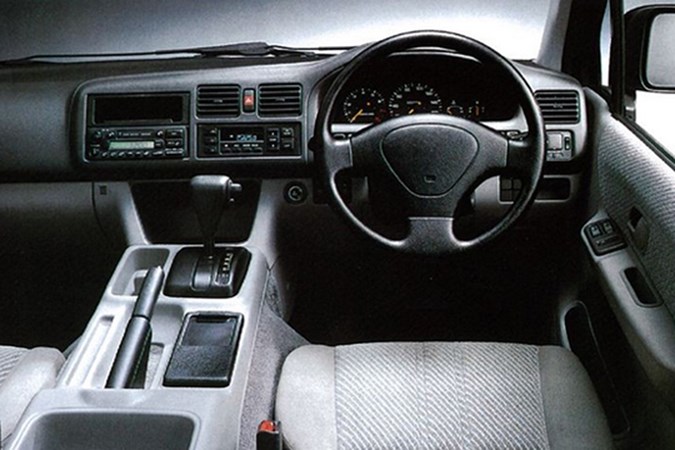
What should I look out for when buying a Mazda Bongo Friendee?
Rust, rust and a bit more rust. Because Japan doesn’t put salt on the roads in winter, JDM vehicles aren’t rust-proofed. They generally leave Japan in fantastic condition but can quickly deteriorate if they’re left sat on a British dock for months, as often happens. You can, of course, rustproof a JDM vehicle once it arrives in the UK, but few sellers did and only the most knowledgeable of owners thought to.
Faced with UK winters, a great many JDM imports rusted into oblivion in alarmingly short order. Any Friendee that’s been in the UK for more than five years will either have been rust-proofed as soon as it arrived, be a patchwork of repairs, or be in need of repairs. Rust can take hold anywhere and you need to check all of the bodywork including:
- Inside the door openings and under the bonnet.
- In the wheelarches and underneath the floor.
- Under the carpets.
- The roof around the pop-top.
If that sounds off-putting, know there are a lot of Friendees that have been in the UK for years and very well looked after, so there shouldn’t be any problems. If you buy a fresh import, have it rustproofed as soon as possible. It’ll cost around £600 but be worth it in the long run.
What should I look out for mechanically?
The Mazda Bongo Friendee’s petrol and diesel engines are pretty much bulletproof if they’re properly and regularly serviced. There are more than a few knocking around with several hundred thousand kilometres on the clock (Japan uses the metric system), proving the point.
However, the engine is under the front seats and that makes servicing a proper faff. The centre console and passenger seat have to be removed to get at the engine, and even then access isn’t great. You even need to go through the rigmarole just to check the oil level. It’s such a faff that some owners don’t bother with routine maintenance, which can cause problems.
Here are some things to watch out for:
- Overheating caused by a lack of coolant – which can cause a warped cylinder head.
- Diesel engine exhaust gas recirculation valves seizing solid.
- Old, cracked hoses (upgrading to more robust silicone hoses is easy).
- The underpowered 2.0-litre petrol has to work pretty hard for its living, so regular servicing is vital.
- The V6 petrol engine is a proper pain to work on and head gasket failures are not unknown.
- Jerky automatic gearchanges mean new transmission fluid and filter are needed.
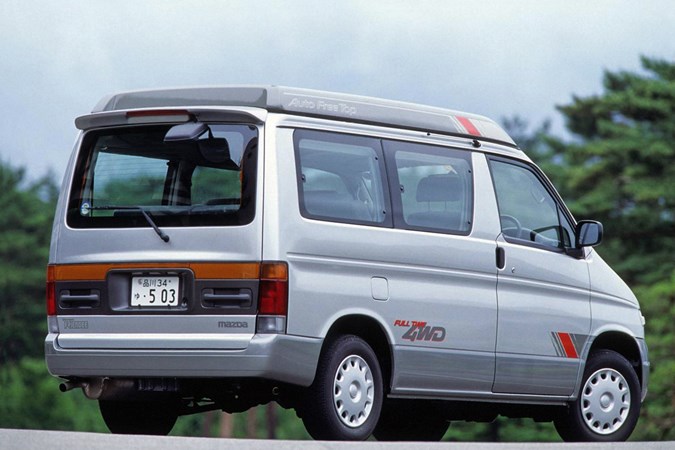
What should I be aware of inside the Mazda Bongo Friendee?
The first job is to make sure everything works as it should. That includes:
- All the interior electrics, including blinds and doors.
- The heater and air conditioning.
- The seats do all their folding and moving tricks easily.
- The pop-top and the screen that separates it from the interior move smoothly and latch into place firmly.
- Water staining that could indicate failed seals around the top.
The quality of full camper conversions varies wildly. There are plenty that were converted professionally to a very high standard, but there are DIY bodge jobs, as well. Inspect everything closely including:
- How solid the joinery is.
- How smoothly the drawers open.
- How snugly the cupboard doors shut.
- All the electrics work.
- The sockets/switches aren’t loose.
Don’t forget to make sure the layout works for you, particularly that there’s enough storage space. You can always change the décor, so don’t worry too much about that. But make sure the conversion has good bones. You can easily find a more intensive project if you prefer.
Beyond a camper conversion, the interiors of many Friendees have been modified in some way – upgraded stereos and satnavs, flip-down TVs and so on. Make sure any mods have been installed properly and work as they should. Also don’t be surprised if bits of interior trim are broken or missing. Any Friendee is quite old now and plastics do become brittle with age.
Curiously, Friendees from northern Japan have two 12-volt batteries, which helps keep the car going during the ultra-cold winters there. That’s a real bonus when doing a camper conversion because you’ve already got an extra electricity supply for the interior.
What’s the story on maintenance?
There are a lot of garages that specialise in servicing and repairing the Mazda Bongo Friendee dotted around the UK – Bongo Fury is widely regarded as the best of them. So you shouldn’t be too far away from someone who can look after yours.
Because there are so many specialists and so many vehicles here, there’s a relatively plentiful supply of spare parts available. Everything from basic service items such as oil filters to bits of suspension and rubber seals.
But the Friendee has been out of production for 20 years, so it’s inevitable that certain parts are becoming quite hard to find. Still, a good specialist should have a large stock of everything that might be needed, or will know where to find it in Japan. Without that knowledge, trying to find parts yourself can be a proper pain.
It is possible to DIY servicing on a Friendee, but the terrible engine access means you need patience and some flexibility to contort yourself into the more awkward areas.
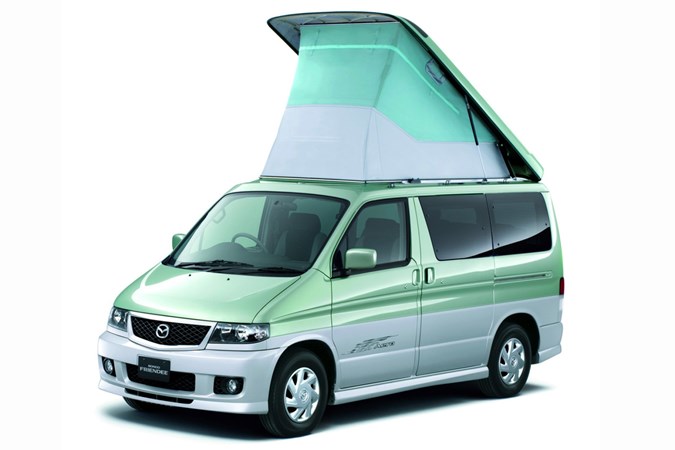
How many miles to the gallon does a Mazda Bongo Friendee do?
The Friendee is a big, heavy vehicle that, even with a diesel engine, can struggle to do much more than 25-30mpg. Expect to get more like 20-25mpg from the 2.0 petrol engine, and 15-20mpg from the 2.5 V6 petrol. It doesn’t help that the fuel gauge is notoriously inaccurate, so you can never be quite sure how much fuel there is. Vehicle excise duty costs around £250 per year and there are plenty of insurance companies that will cover a Friendee.
What else should I know?
Japan uses the metric system, so the Mazda Bongo Friendee’s speedo and odometer are in kilometres. There are kits available for converting them to read in miles. You’ll find Japanese script throughout the vehicle, as well, including on some of the buttons and stalks.
Similarly, a Bongo’s factory owners’ manual and its early service history are in Japanese. English translations of the manual are available; it’s harder to translate a service history. Diligent UK owners should have kept any invoices and other paperwork they’ve accumulated.
Many Friendees have deflectors around the front windows, so you can have them down without being deafened by the wind. They can become brittle and break with age; make sure they’re not broken or cracked as replacements may be expensive.
Japanese law required all MPVs of this era to be fitted with an extra mirror attached to the tailgate that should be angled so you can see what’s directly behind the vehicle. Without the mirror, that area is a huge blind spot. The whole assembly can go rusty and break off. Replacements in good condition can be hard to find.
All sorts of accessories for the vehicle’s exterior were available from the factory, and there are loads you can buy from UK suppliers. Make sure any fitted to a vehicle you’re thinking about buying are securely attached and in good condition.
That includes towbars. The Friendee is a capable tow car – Bongo Fury recommends towing a maximum of 1,650kg. Just bear in mind that pulling that kind of weight will make the Friendee even slower and drink a lot more fuel.
If you’re planning on doing a DIY camper conversion on a Friendee, be careful about how much weight you add to the vehicle. Depending on model, the Friendee has a gross vehicle weight of up to 2,500kg; with an unladen of circa 1,700kg, you can safely add a few hundred kilos. Vehicle weights are listed on the vehicle identification number plate.
There are plenty of car traders that import Friendees, however it is possible to go it alone and find your own. Check out our guide on importing a car to the UK.
Pricing
You can pick up a perfectly serviceable Mazda Bongo Friendee still in its original MPV form for about £4,000. A project that needs some work to make it good can be picked up for less than £3,000. Fresh imports from Japan are typically £5,000 to £7,000, depending on model and condition.
There are Friendees that have been fully converted into campers available for around £5,000, but they’ll need a few grand spending on them. Budget £15,000 to £20,000 if you want one with a high-quality conversion in ready-to-go condition.
Verdict
There’s a lot to recommend the Mazda Bongo Friendee. As an MPV, it’s hugely spacious and versatile, and easy and comfortable to drive. Yes, it’s big, but not so big as to be impractical for daily driving. As a campervan, the Friendee’s factory-fitted pop-top is a massive bonus, and the interior’s vast space allows you to be a bit creative with the layout.
It’s a relatively easy vehicle to own, as well. Accessing the engine may be difficult but there are plenty of specialists who can do the work for you, and the plentiful parts supply keeps prices down. Just don’t be surprised about the size of the fuel bill.
But its biggest selling point is value for money. Whether you buy one in MPV or campervan form, the Friendee costs a lot less than many European equivalents. Particularly Volkswagens.
Just so you know, we may receive a commission or other compensation from the links on this website - read why you should trust us.


